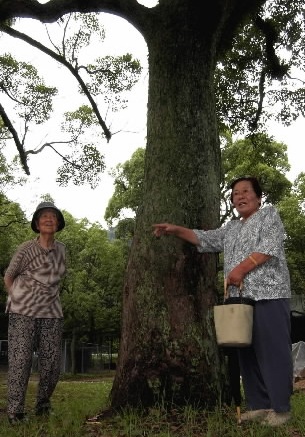Ninoshima Island, Awakening from Slumber, Part 2
Jun. 28, 2010
Field hospital flooded with casualties
by Kunihiko Sakurai and Aya Kano, Staff Writers
Fifty-nine years after the dropping of the atomic bomb [this series was originally published in July 2004], the remains of many atomic bomb victims are being found on Ninoshima, a small island off the coast of Hiroshima. The fact that they are just now being exhumed reveals the vast scope of the devastation wrought by the bombing. The brittle, dark brown bones are reminders of the long years that have elapsed, forgotten by the public. In this series the Chugoku Shimbun examines how we should remember the atomic bombing experience and how we should convey that experience to the next generation.
A camphor tree stands at the municipal Seaside Children's Nature Center on the east coast of Ninoshima. It is covered with dark green leaves, and moss grows on its trunk. On the day of the atomic bombing, this large tree saw the flash of the atomic bomb and witnessed the flood of victims that came to the island in the aftermath of the bombing.
"It's much bigger now," said Kayano Okumoto, 83, who lives on the opposite side of the island, as she gazed up at the tree. She described the days when part of the island was used as an army quarantine station for soldiers returning from battlefields overseas.
Ms. Okumoto worked here as an employee of the army. Every day she passed under the branches of the camphor tree, which stood at the entrance to the medical ward. A sumo ring where soldiers often wrestled had been made nearby.
Just after the dropping of the atomic bomb, the No. 2 quarantine station was turned into an emergency field hospital for the injured. The facility was filled with victims, whose faces and bodies were red and swollen. One minute they were breathing and a few minutes later their bodies were stacked in the sumo ring. "Standing here now, I can picture that mountain of bodies," she said with quivering lips.
Yukie Horiguchi, 82, a childhood friend of Ms. Okumoto's who was standing beside her, nodded. At the time of the atomic bombing, she was a teacher at Ninoshima Elementary School. It is believed that roughly 10,000 victims were brought to the field hospital on the island. Ms. Horiguchi helped care for them. Their medicine soon ran out, so ashes were applied to the victim's burns as a stopgap measure.
Ms. Horiguchi happened to catch the eye of a naked young man with a vacant expression. In a state of delirium he repeatedly murmured, "Mom, give me some soybeans." Ms. Horiguchi was concerned about the safety of her former students who had left the island to attend junior high school.
Even now there are many people on Ninoshima who remember those days. Tsutsumi Shine, 70, was a fifth-grader at Ninoshima Elementary School. Through the windows of the field hospital he heard people moaning and pleading for water. Frightened by a photographer's flash, the injured tried to flee. "It was as if they thought they were going to be bombed again," Mr. Shine said.
Toshie Hirata, 71, who now lives in Ujina on the opposite shore, was a first-year student at Ninoshima Junior High School. Every day she went to the field hospital to care for a woman she knew. Told that the victims would die if given water, Ms. Hirata used the rind of a watermelon to cool the face of the woman, who sucked desperately at the rind.
When the air raid warning sounded, the victims also headed for the air raid shelter, dragging their skin, which had peeled from their burns. "It scraped the ground making a swishing sound," Ms. Hirata said. "It was pitiful." Those victims never emerged from the air raid shelter.
Soldiers carried their bodies to the equine quarantine station about 600 meters south of the No. 2 quarantine station on two-wheeled carts or stretchers. This is the site of the current excavation being conducted by the city.
As if they were logs, one after another the soldiers threw the bodies into a hole that was ordinarily used to bathe horses. They then poured oil over the bodies and burned them. At night, sea water was used to put out the flames so they would not become a target for enemy aircraft, and the next morning more bodies were burned. Before long the bodies could not be burned fast enough, so they were buried instead.
"The soldiers worked terribly hard. I suppose they had no choice," Ms. Hirata said, gazing up at the sky.
(Originally published July 17, 2004)








